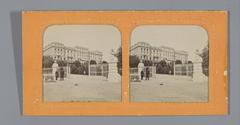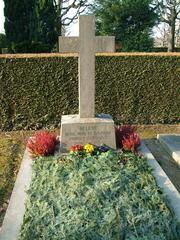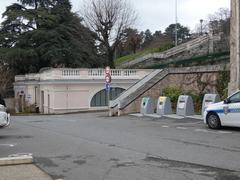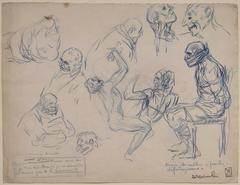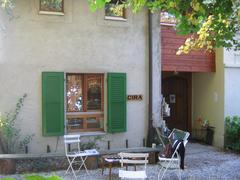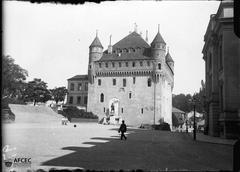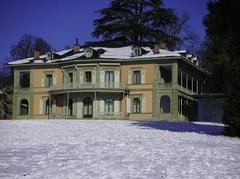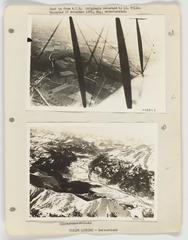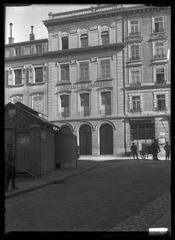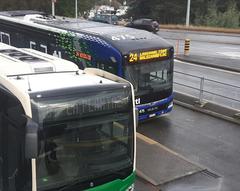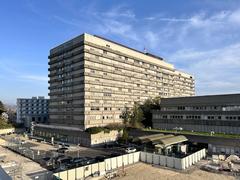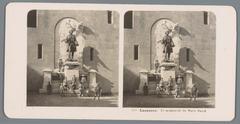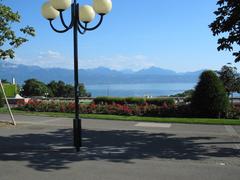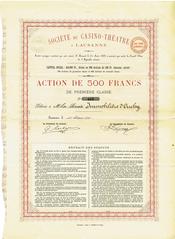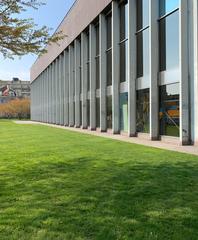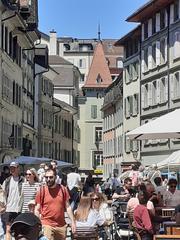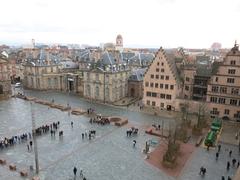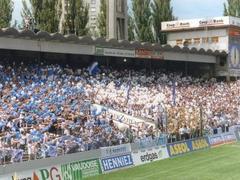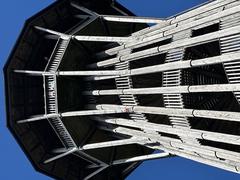Cantonal Museum of Archaeology and History, Lausanne: Comprehensive Guide to Visiting Hours, Tickets, and Collections
Date: 15/06/2025
Introduction
The Cantonal Museum of Archaeology and History (Musée cantonal d’archéologie et d’histoire, MCAH), situated in the heart of Lausanne within the grand Palais de Rumine, is an essential cultural institution for anyone interested in the rich heritage of the Canton of Vaud and the Lake Geneva region. Since its establishment in the early 20th century, the MCAH has grown into a cornerstone of regional history, housing over 250,000 artifacts that trace the story of humanity from the last glaciations through to the present day (official MCAH website).
This guide provides a detailed overview of the museum’s historical development, collection highlights, practical visitor information, and its architectural setting within the Palais de Rumine. Whether you’re a passionate historian, a student, or a curious traveler, you’ll find all the details needed to plan a rewarding visit.
Table of Contents
- Introduction
- Museum Origins and Development
- Mission and Key Functions
- Collection Highlights
- Research and Community Engagement
- Planning Your Visit
- Palais de Rumine: History and Architecture
- Museum Layout and Visitor Experience
- Facilities and Services
- Nearby Attractions
- Visitor Tips
- Frequently Asked Questions
- Conclusion
- References and Further Reading
Museum Origins and Development
Officially founded in 1908, the MCAH emerged from a growing regional interest in archaeology and historical preservation. It was conceived as a central repository for artifacts unearthed throughout Vaud, especially after intensified excavations in the late 19th and 20th centuries (official MCAH website).
From its inception, the museum has been housed in the iconic Palais de Rumine, a Renaissance-style building at Place de la Riponne, making it a prominent feature of Lausanne’s civic and cultural landscape.
Mission and Key Functions
The MCAH is dedicated to:
- Conserving, restoring, and cataloging archaeological and historical artifacts from the region.
- Conducting and supporting archaeological research.
- Presenting permanent and temporary exhibitions for the public.
- Managing external depots, such as the Dépôt et Abri de Biens Culturels (DABC) and the lapidary warehouse at Lausanne Cathedral (Iron Age Europe - MCAH).
Collection Highlights
Prehistoric and Iron Age
The museum’s prehistoric gallery illustrates human settlement in Vaud over 15,000 years. Highlights include:
- Princely Chariot Tomb of Payerne: A remarkable First Iron Age burial site, providing insight into Celtic elite customs.
- Saint-Sulpice Necropolis: Grave goods such as glass, bronze, and coral jewelry from the 4th century BC, with a reconstructed funeral context.
- Mormont Cult Site: Finds that shed light on Celtic rituals and society.
Exhibits feature stone tools, ceramics, and organic materials preserved in local wetlands (source).
Roman and Medieval Periods
Artifacts from the Roman town of Lousonna, mosaics, coins, and everyday items narrate Lausanne’s transformation under Roman rule. The medieval collection covers religious, economic, and social changes, including treasures from Lausanne Cathedral and feudal castles (Evendo - MCAH).
Numismatics and Applied Arts
Since 2019, the museum’s holdings have been enriched by the Canton’s coin and medal collections, which trace economic and political history through thousands of pieces (mcah.ch). The applied arts collection features furniture, textiles, and donated objects reflecting daily life in Vaud.
Classical Antiquity and Special Collections
Significant donations include Greek, Carthaginian, and Etruscan pieces (notably from the François Tomb in Vulci), as well as Near Eastern antiquities from the René Dussaud Collection (mcah.ch).
Research and Community Engagement
The MCAH serves as a hub for archaeological research with state-of-the-art conservation labs. It collaborates with academic bodies and heritage organizations locally and internationally. The museum offers educational programs, family workshops, and interactive displays to engage all audiences (source).
Preventive archaeology, mandated since 1912, ensures that all regional finds are preserved, resulting in thousands of new items annually (mcah.ch).
Planning Your Visit
Location
- Address: Palais de Rumine, Place de la Riponne 6, 1005 Lausanne, Switzerland
- Public Transport: Metro M2 (Riponne-Maurice Béjart), bus lines 1, 2, 7, 8, 16, 18, 60
- Parking: Parking de la Riponne nearby (visitor information)
Opening Hours
- Tuesday to Sunday: 10:00 AM – 5:00 PM
- Closed: Mondays and certain holidays
- Special Events: Extended hours for events like the Night of the Museums (Night of the Museums)
Admission Fees
- Permanent Exhibitions: Free
- Temporary Exhibitions: Adults CHF 8, reduced CHF 5, under 25s free, first Saturday of each month free
- Advance Booking: Not required for general visits (official visitor info)
Accessibility
The museum and Palais de Rumine are wheelchair accessible, with elevators, ramps, and adapted restrooms. Assistance for visitors with reduced mobility is available (Palais de Rumine accessibility page).
Guided Tours and Special Events
- Regular guided tours in French and English (evendo.com)
- Educational workshops and family events, especially during museum nights and special exhibitions.
Palais de Rumine: History and Architecture
Origins and Patronage
The Palais de Rumine owes its existence to Gabriel de Rumine’s bequest in 1871, which funded the creation of a major public building for Lausanne. Construction, led by architect Gaspard André, began in 1892 and the palace was inaugurated in 1902 (lausanne.ch; wikipedia).
Architectural Features
- Style: Florentine Renaissance Revival, emphasizing cultural and academic ideals (touringswitzerland.com)
- Notable Elements: Monumental facade, central atrium, grand staircase, galleries adorned with marble and decorative stonework.
Institutional Role
Originally housing the University of Lausanne and several museums, today the palace is home to multiple cantonal museums and the Cantonal and University Library (lausannemusees.ch). The palace’s adaptability has ensured its continued importance in Lausanne’s cultural life.
Museum Layout and Visitor Experience
- Level 1: Main archaeology and history galleries (Troyon and Naef rooms)
- Level 3: Coins and Medals collection
- Temporary Exhibition Spaces: Regularly updated with new discoveries and thematic shows (museum layout)
Permanent Exhibition Highlights
- Lakeside Settlements: Bronze Age objects from Lake Geneva, including the Corcelettes Ashwood Wheel.
- Neolithic and Bronze Age: Stone axes, bead necklaces from Pully Chamblandes.
- Roman and Celtic Finds: Artifacts from Orbe-Boscéaz and reconstructed funerary contexts.
- Medieval Artifacts: Ecclesiastical treasures and feudal regalia.
- Numismatics: “Lay your money down!” interactive displays (coins and medals).
Temporary Exhibitions
- 2024–2025: “Autobiography of a Métis Saddle” (focus on cross-cultural objects, contemporary Métis beadwork) (CBC News)
- “Collections Printemps 2025” and “Spécimens 24. Nos collections racontent…”: Recent discoveries and collaborative displays (mcah.ch)
Facilities and Services
- Library: Open Tuesdays and Thursdays (library info)
- Cloakroom and Restrooms: Available onsite
- Museum Shop: Books, souvenirs, and educational materials
- Catering: Refreshments during special events (event catering)
Nearby Attractions
- Lausanne Cathedral: A Gothic landmark within walking distance
- Plateforme 10 Arts District: Modern arts hub nearby
- Ouchy Waterfront: Accessible by metro for lakeside recreation
Visitor Tips
- Allow 1.5–2 hours for a full visit
- Exhibits are primarily in French, with English translations on key items; staff are multilingual
- Non-flash photography is generally permitted
- First Saturday of each month and special cultural days offer free admission
- Check the museum agenda for workshops and guided tours (museum agenda)
Frequently Asked Questions (FAQ)
Q: Are tickets available online?
A: Tickets are purchased onsite; advance booking is not needed for regular visits.
Q: Is the museum fully accessible?
A: The Palais de Rumine is wheelchair accessible; the museum offers partial accessibility.
Q: Can children visit?
A: Yes, with dedicated educational activities and family-friendly workshops.
Q: Are guided tours available?
A: Yes, in French and English, and for organized groups or school visits.
Visual and Digital Resources
The museum’s website provides virtual tours, maps, and high-resolution images. Onsite, interactive displays and digital kiosks enhance the visitor experience.
Contact Information
- Address: Cantonal Museum of Archaeology and History, Palais de Rumine, Place de la Riponne 6, CH-1005 Lausanne, Switzerland
- Phone: +41 (0)21 316 34 30
- Website: Contact page
Conclusion
The Cantonal Museum of Archaeology and History in Lausanne is a vital destination for anyone eager to explore the cultural roots of Vaud and Switzerland. Its unique collections, central location, and integration with the architectural marvel of the Palais de Rumine make it an enriching stop for history lovers and families alike. For up-to-date information, ticketing, and event details, refer to the official museum website and consider downloading the Audiala app for a digitally enhanced visit.
References and Further Reading
- Cantonal Museum of Archeology and History (MCAH) Lausanne: History, Collections, Visiting Information & More (lausannemusees.ch)
- Palais de Rumine in Lausanne: Visiting Hours, Tickets, and Historical Significance (touringswitzerland.com)
- Palais de Rumine - Lausanne City Official Website (lausanne.ch)
- Iron Age Europe - MCAH (Iron Age Europe - MCAH)
- Cantonal Museum of Archaeology and History Visiting Hours, Tickets & Visitor Guide in Lausanne (mcah.ch)
- Evendo - MCAH (Evendo - MCAH)
- Wikipedia - Palais de Rumine (wikipedia)
